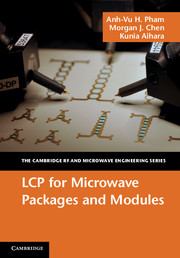Book contents
- Frontmatter
- Contents
- Preface
- 1 Introduction to electronic package engineering
- 2 Characteristics of liquid crystal polymer (LCP)
- 3 Fabrication techniques for processing LCP
- 4 LCP for wafer-level chip-scale MEMS
- 5 LCP for surface mount interconnects, packages, and modules
- 6 LCP for passive components
- 7 LCP for system design
- 8 LCP reliability
- Abbreviations, acronyms, and symbols
- Index
- References
3 - Fabrication techniques for processing LCP
Published online by Cambridge University Press: 05 July 2012
- Frontmatter
- Contents
- Preface
- 1 Introduction to electronic package engineering
- 2 Characteristics of liquid crystal polymer (LCP)
- 3 Fabrication techniques for processing LCP
- 4 LCP for wafer-level chip-scale MEMS
- 5 LCP for surface mount interconnects, packages, and modules
- 6 LCP for passive components
- 7 LCP for system design
- 8 LCP reliability
- Abbreviations, acronyms, and symbols
- Index
- References
Summary
In this chapter we describe and discuss the processes used to fabricate liquid crystal polymer (LCP) for microwave packaging. The normal fabrication techniques have had to be in some cases modified or even reinvented for LCP owing to the unique challenges in working with this inert material. While LCP’s chemical inertness makes it attractive for maintaining electrical performance over wide-ranging environmental conditions, it also means that LCP can be difficult to use in wet chemistries. These issues are complicated further by the fact that LCP is a plastic that can be easily flexed in thin-film form. An inherently anisotropic chemical structure adds an additional complication.
This chapter will progress through the different techniques available to form multilayer circuits and packages using LCP. In section 3.1 we discuss the available LCP formats, which include pellets and laminates. In section 3.2 we explain how copper cladding is added to LCP laminates and made ready for printed circuit board (PCB) processing. Section 3.3 covers the whole process, from laminate material to complete printed circuit board, using standard PCB technology. In section 3.4 we describe advanced process techniques that allow for complex specialized constructions. Lastly, section 3.5 gives a chapter summary.
- Type
- Chapter
- Information
- LCP for Microwave Packages and Modules , pp. 41 - 71Publisher: Cambridge University PressPrint publication year: 2012

